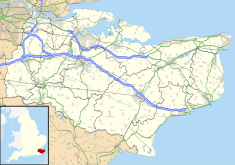Margate Town Hall
| Margate Town Hall | |
|---|---|
 Margate Town Hall | |
| Location | Market Place, Margate |
| Coordinates | 51°23′22″N 1°22′55″E / 51.3894°N 1.3820°E |
| Built | 1898 |
| Architectural style(s) | Neoclassical style |
Listed Building – Grade II | |
| Official name | Old Town Hall and Police Station |
| Designated | 22 February 1973 |
| Reference no. | 1351074 |
Margate Town Hall is a municipal building in the Market Place, Margate, Kent, England. The complex, which was the headquarters of Margate Borough Council, consists of the two distinct buildings connected by a bridge: it is Grade II listed.[1]
History[edit]

After a charter was granted giving permission to hold markets in the town in 1777, an existing building owned by the Cobb family in an area known as the Bowling Green was converted for use as a town hall in 1787.[2] At the same time a new lock-up was built to the north of the town hall.[2] After the original town hall became dilapidated, a new town hall, funded by public subscription, was built on the same site and completed in 1820.[2]
The town became a municipal borough in 1857,[3] and following further population growth, largely associated with seaside tourism, the borough council decided to commission new municipal offices on the same site in the 1890s: this became possible because of a gift from Martha Hannah Kendal, widow of a former local corn merchant, Alderman Daniel Kendal.[2] The new building was designed in the neoclassical style, built with brick rendered with cement and completed in 1898.[2] The design involved a symmetrical main frontage with four bays facing onto the southern edge of the Market Square; the ground floor was arcaded so that markets could be held and featured a cast iron canopy which originally extended the full width of the building.[1] There were sash windows on the first floor with a large pediment above and, at roof level, there was clock with a lantern above.[1] Internally, the principal parts of the building were the courtroom, which was also used as a council chamber, on the first floor and the police station on the ground floor.[2] The police moved out of the complex to a new police station at Fort Hill in 1959.[2]
The building continued to serve as the headquarters of Margate Borough Council for much of the 20th century but ceased to be the local seat of government when the enlarged Thanet District Council established its offices in Cecil Street shortly after it was formed in 1974.[4][5] The first floor of the front part of the complex subsequently became the home of the mayor and the charter trustees.[6] The rear part of the complex was converted for community use and re-opened as the Margate Museum in 1987.[7] The museum's initial exhibits included a collection of maps and local historical documents collected by Dr Arthur Rowe, which had been left to Margate Corporation when he died in 1926,[8][9] as well as a series of paintings known as the Parker Collection which was purchased by Margate Corporation in 1929.[10]
The East Kent Maritime Trust took over management of the museum in 1994 and, after a brief closure from 2008 to 2010, it reopened under the management of a team of volunteers.[11] In September 2018, the council considered a proposal to let out the ground floor of the front part of the complex for commercial use.[12]
References[edit]
- ^ a b c Historic England. "Old Town Hall and Police Station (1351074)". National Heritage List for England. Retrieved 16 February 2021.
- ^ a b c d e f g "Historical Margate". The Mayor and Charter Trustees of Margate. Retrieved 16 February 2021.
- ^ "Margate MB". Vision of Britain. Retrieved 16 February 2021.
- ^ Local Government Act 1972. 1972 c.70. The Stationery Office Ltd. 1997. ISBN 0-10-547072-4.
- ^ "No. 46732". The London Gazette. 7 November 1975. p. 14114.
- ^ "Margate Museum and Old Town Hall". Thanet District Council. Retrieved 16 February 2021.
- ^ "Margate Museum and the Thanet District Council art collection" (PDF). Thanet District Council. Retrieved 16 February 2021.
- ^ "Our History". Shottendane House. Retrieved 16 February 2021.
- ^ "Margate's Unsung Hero: Arthur Walton Rowe" (PDF). Margate Civic Society. 2006. Retrieved 16 February 2021.
- ^ "Nineteenth-century Turner print sold at local auction-house" (PDF). Margate Civic Society. 2010. Retrieved 16 February 2021.
- ^ "Tribute paid to Margate Museum Trustee and town history stalwart Ian Dickie". Isle of Thanet News. 11 November 2020. Retrieved 16 February 2021.
- ^ "Some of Thanet's biggest tourist attractions could close if massive refurbishment bills cannot be paid". Kent Live. 20 September 2018. Retrieved 16 February 2021.

